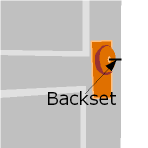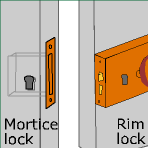THE SECRETS BEHIND BUYING
TRADITIONAL DOOR KNOBS
More background information
- Video
- Video of cast iron bath manufacturing
- Video of lost wax casting
- Video of chinaware manufacturing
- Bathroom design
- Victorian bathroom design
- Create an art deco bathroom suite
- How to restore your bathroom
- Nine Reasons not to restore your bathroom
- Door furniture
- The secrets behind buying traditional door knobs
- The lost wax process
- Bathroom techniques
- Bath casting
- Bath enamelling
- Bath finishing
- External links
Reclaimed or repro and other considerations
for buying period door hardware
Many people seem to find choosing antique style door hardware a minefield. The truth is that there are no rules, but there are number of questions and checks that make the process of buying a traditional door knob more likely to be successful.
1: Door knob or door handle?
 First thing to look at is your backset - the measurement from the edge of your door to the centre of the hole drilled for the lock. Check that it looks long enough not to trap your fingers if you tried to turn a door knob. If itís too short, get a door handle (lever or drop style) instead.
First thing to look at is your backset - the measurement from the edge of your door to the centre of the hole drilled for the lock. Check that it looks long enough not to trap your fingers if you tried to turn a door knob. If itís too short, get a door handle (lever or drop style) instead.
2: Budget Ė cheap knobs let you down
Many people make the mistake of economising (or running short of money) at the crucial finishing stage of a building project.
Error. Donít cut corners on items that are used and seen every day. Budget for the finishing details when you start out so cheap door knobs donít show you up.
3: Do you have a rim lock or mortice lock
 What are these? A mortice lock is set within the door thickness rather than being mounted to its surface, while a rimlock is a box planted on the side of the door that catches in a corresponding box mounted on the door frame.
What are these? A mortice lock is set within the door thickness rather than being mounted to its surface, while a rimlock is a box planted on the side of the door that catches in a corresponding box mounted on the door frame.
Why does this matter? Well, with a rimlock the knobs on either side of the door differ to accommodate the different locking mechanisms. In fact, only one rose is absolutely necessary with a rimlock.
So it is important to determine that the knob you want is designed for your type of lock. If the hardware you have chosen is for the wrong sort of lock, it may be possible to make it work anyway:
- Door hardware designed for rimlocks: it may be possible to add a rose
- Some door hardware designed for mortice locks will run on a rim lock just by removing a rose Ė ask your supplier if the knob has a threaded spindle
4: Which style?
This is really up to you.
- Do you want style to conform to the rest of the house, just to the door, or even just to one side of the door?
- Or just choose what you like and blow the rest of the house
5: Which material?
Brass, iron, wood and glass are the most common. Donít rule out combinations of say brass and glass, brass and wood and even onyx and brass.
- Brass is by far the most common material. It has the major advantage of not rusting or rotting, and is decorative when polished but gains an attractive patina if left over time. It is also easy to plate to get a silver or copper finish. Many brass knobs have been heavily polished which allows you to look at the brass colour and quality. These will tarnish down to a wonderful patina over time providing they are not lacquered. Remember that when they were made they were very highly polished.
- Brass plate: never attempt to reclaim a brass plated knob, it will only cause grief.
- Iron knobs need protecting unless they are pure black iron which is very slow to rust. The most common form of protection is to paint them, but oiling and waxing look more natural and will wear to a nice patina over time.
- Wood is also common. Ebony and fruitwoods are traditional but modern hardwoods are often used now, often stained to look like ebony. Most wooden knobs have brass internal sleeves that hold the workings. Cracks in wooden door knobs are normally not too serious and add to the character.
- Ceramic or glass in various forms are often used in place of wood. These doorknobs still rely on brass working parts. Look for hairline cracks. Some are acceptable and will not affect the performance but occasionally they can be fatal.
6: Reclaimed or new?
- How many matching sets do you need? There are very few long runs of matching reclaimed doorknobs around nowadays but you might be lucky, especially if you have the time to search (some people take a few years to collect them).
- It is much easier to take the new route, especially when copies can easily be made of genuine antique knobs that are virtually indistinguishable from the original except for no wear on the spindles and roses. Oh, and they work of course!
- Drummonds also has available off the shelf a range of door knobs copied from favourite originals.
Final checklist for reclaimed door hardware
If you have taken the reclaimed route, there are a number of checks worth making to ensure the knob or handle fuctions as it should.
Check 1 - spindles:
Is the spindle size the right one for the lock?
- Too small: the knob will rattle and thereís nothing you can do to fix it. Don't buy this knob.
- Too big: it simply wonít fit. This can be fixed if you donít mind a bit of extra work filing off some off the spindle, or opening out the square in the lock with a triangular file.
Check 2 - excessive wear:
- Worn spindle: normally easy to replace (unless it is threaded)
- Worn sockets: are more difficult (and quite rare)
- Grub screws: Does it have them all and do they turn? Most old knobs are imperial threaded or, if mid Victorian or earlier, are likely to have individual threads peculiar to that particular manufacturer so do not lose the grub screw. If you have to replace a grub screw it is usually quicker and easier to drill it out and re-thread it to a modern metric thread. Then at least you know it will work, and you will be able to replace the grub screw if you lose it!
- General wear and tear: some surface wear and tear will make a reclaimed knob look as if it has been in place for years, so do not dismiss it just because it is not perfect
Check 3 - fixing system:
Make sure you know how the fixing system works. Some good quality knobs have sophisticated split collar fixing systems which can be quite complex and are a nightmare to detach from the door if you donít know how they work:
- Either the fixing system falls apart as you undo the rose and you lose half the bits (difficult to know if you have lost any until you re-assemble it)
- Or the fixing system will not come apart as it has seized up and there appears to be no way to take it apart.
Not surprisingly, not many of these types of door knobs have been reclaimed.
Summary
In summary, buy good quality and what you like and it will serve you well for many years.
Author: James Walker, Drummonds
Site links:

